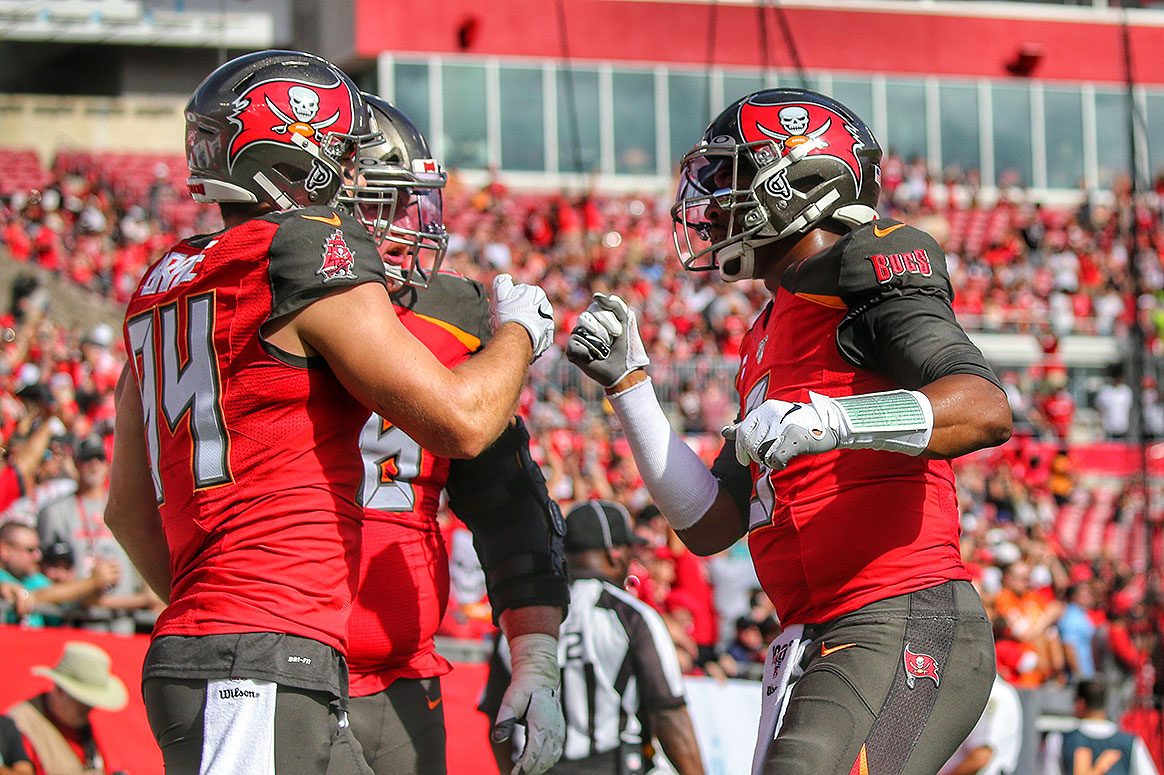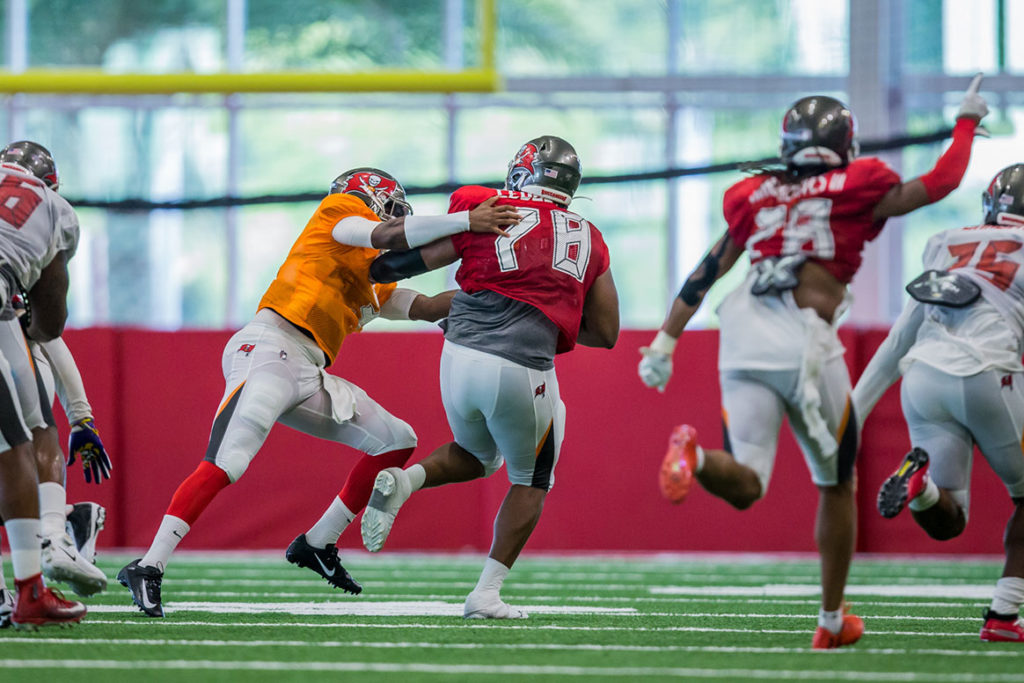Following a 2-6 start to the 2019 season, Tampa Bay rattled off four wins in five games before dropping two one-score contests to the Texans and Falcons, ending any chance of the Bucs finishing a season at .500 or better for the first time since 2016.
PewterReport.com offers its season grades for each Bucs unit and the coaching staff. On Tuesday we offer up grades for the offense and on Wednesday we will dish out the grades for the defense.
Take a look and see if you agree, and share your thoughts in the comments section below.
QUARTERBACKS
Jameis Winston has always carried the reputation of a high variance quarterback, flashing moments of brilliance before turning around and leaving people scratching their heads after some of his decisions, and that variance was at an all-time high in 2019.

Bucs QB Jameis Winston – Photo by: Cliff Welch/PR
In his first 16-game season since 2016, Winston led the league with 626 pass attempts and 5,109 passing yards and finished second in the league with 33 touchdowns passes in 2019, but also led the league with 30 interceptions and set an NFL record with seven interceptions returned for touchdowns. The closest player to Winston’s interception total was Cleveland’s Baker Mayfield at 21.
In a critical option year for both Winston and the Bucs, as the decision of whether or not to move forward with the former first overall pick is tougher than ever, he showed some of his greatest highs and most frustrating lows.
Grade: C
RUNNING BACKS
It was an interesting year for Tampa Bay’s committee of running backs. While second-year back Ronald Jones seemed to be the clear-cut leader in the backfield from a talent and production standpoint, his deficiencies in pass protection and catching passes out of the backfield were a significant hindrance in his ability to see the field early in the season as Peyton Barber carried the starting role into early November.
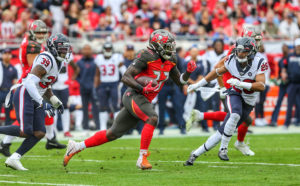
Bucs RB Ronald Jones – Photo by: Cliff Welch/PR
As a whole the unit was unproductive, ranking 28th in the NFL with a meager 3.7 yards per attempt and 24th in the league with 95.1 yards per game, not producing a 100-yards rusher until Week 17 but that isn’t just on the running backs themselves.
Jones led the backfield with 724 rushing yards on 4.2 yards per carry, followed by Barber at 470 yards on 3.1 yards per carry, but the Bucs’ running backs were also stuffed – meaning they were hit at or behind the line of scrimmage – on 23 percent of their carries according to Football Outsiders. Only Miami and Pittsburgh were stuffed at a higher rate.
Grade: C
WIDE RECEIVERS
If it was possible to give this unit a grade higher than an A+, we would do it.
Mike Evans continued his run as one of the most dominant pass-catchers in the league in 2019, becoming just the second receiver in NFL history to start a career with six consecutive 1,000-yard seasons.
Across from Evans, Chris Godwin broke out as a genuine superstar this past year after playing third fiddle to Evans and DeSean Jackson since being drafted in the third round of the 2017 draft.
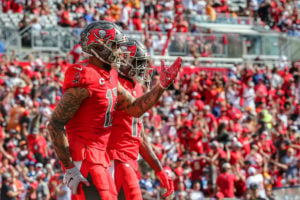
Bucs WRs Mike Evans and Chris Godwin – Photo by: Cliff Welch/PR
Despite both of their seasons ending early due to hamstring injuries late in the year, Evans’ finished the year 13th in the league with 1,157 receiving yards and tied for eighth in the league with eight touchdown receptions over 13 games while Godwin finished third in the league with 1,333 receiving yards and tied for fourth in the league with nine touchdown receptions over 14 games.
Behind the Bucs’ dynamic duo, while Breshad Perriman surpassed 20 receiving yards just once over Tampa Bay’s first 11 weeks, he finished the year on a tear and hit career highs with six touchdown receptions and 645 receiving yards. After Perriman, it was a plethora of fill-in players who were forced to step up in the midst of an injury-riddles unit, with rookie Scotty Miller hitting 200 receiving yards with a touchdown and second-year receiver Justin Watson adding 159 receiving yards and two touchdowns of his own.
Grade: A+
TIGHT ENDS
O.J. Howard was healthy for much of the 2019 season, but despite playing in 14 games he produced career lows in yards per reception and receiving touchdowns, hauling in just one touchdown on the year. His lack of production and primary usage as a blocker goes hand-in-hand with some of his unfortunate mistakes this past season, including two interceptions that went off the hands of the third-year tight end and a costly red zone fumble against San Francisco 49ers.
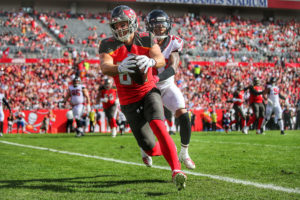
Bucs TE Cam Brate – Photo by: Cliff Welch/PR
As for Cam Brate, while his yardage and reception numbers in 2019 increased marginally from his 2018 campaign, he generated the lowest yards per reception average(8.6) of his career and produced just four touchdowns after catching no less than six in the three seasons prior. The 36 catches and 311 receiving yards were far below the expectation that comes with his $7 million price tag.
The third tight end spot was a rotation of Antony Auclair, whose season ended prematurely due to a toe injury, preseason standout Tanner Hudson and baseball player turned tight end Codey McElroy. The trio combined for just 67 receiving yards on four receptions.
Grade: C
OFFENSIVE LINE
The biggest success for Tampa Bay’s offensive line in 2019 was their ability to remain healthy, for the most part, and the improvement of right guard Alex Cappa.
While Cappa was forced to miss three games and the tackle tandem of Demar Dotson and Donovan Smith missed a game each, the unit was largely held intact and showed improvement, even if it didn’t show up in the stat sheet.

Bucs C Ryan Jensen – Photo by: Cliff Welch/PR
Tampa Bay’s offensive line allowed 47 sacks, good for 11th-most in the league, and 107 quarterback hits, but also had a passer who tied for the league-lead in pass attempts. According to Football Outsiders, Tampa Bay’s adjusted sack rate – which takes sacks per pass attempt but adjusts for the down, distance and opponent – was 7.6 percent, which would put them at 22nd in the league and just north of the league average of seven percent.
As mentioned previously, the issue that remained glaring from the offensive line was their ability to consistently run block. Outside runs and sweeps were rare for good reason and the line allowed the backs to be hit at or behind the line of scrimmage on a regular basis, 23 percent of the time. The Bucs ran behind their interior unit of Jensen, Cappa and left guard Ali Marpet on 70 percent of their runs, the highest mark in the league. The problems frequently left Tampa Bay in passing situations and proved to be an issue late in games when trying to hold a lead, looking at the Bucs’ games against Detroit and Jacksonville as glaring examples.
Grade: C+
COACHING
In his first year as a full-time playcaller in his own offense, the marked improvement made by Byron Leftwich – with the leadership and assistance of former offensive coordinators Bruce Arians, Harold Goodwin, Clyde Christensen and Tom Moore – can’t be overstated.
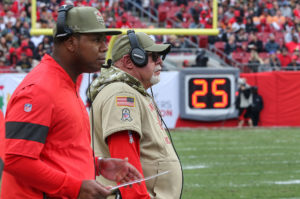
Bucs OC Byron Leftwich and HC Bruce Arians – Photo by: Cliff Welch/PR
Leftwich had his struggles early with seemingly predictable playcalling, a focus on plays that were lengthy to develop and the inability to find a third wide receiver to produce at a high level, but as the season developed so did Leftwich. In year one Leftwich led an offense that finished the season ranked third league-wide in both points and yards, produced two 1,000-yard receivers, made something out of a nearly non-existent run game and continued to produce at a high level when Evans, Godwin and Miller were forced to miss time, leaving Tampa Bay with multiple pass-catchers who were getting their first crack at the NFL level.
It was a promising first season for Leftwich and while head coaching rumors swirl, his performance has to be a pleasant surprise.
Grade: B

